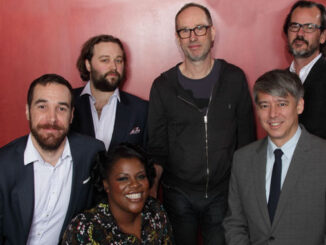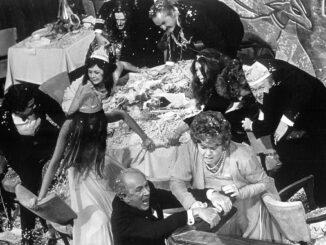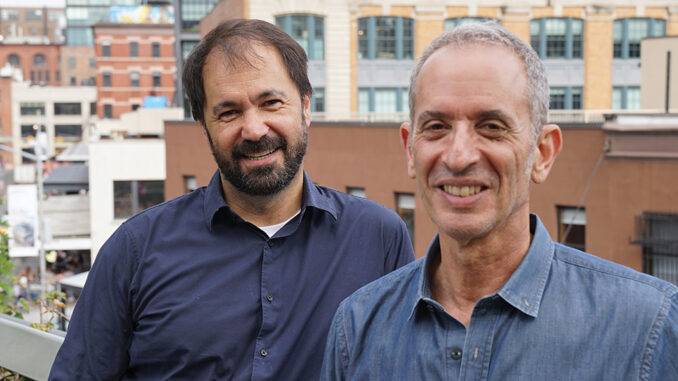
by Rob Feld • portraits by Sarah Shatz
Picture and sound editorial were faced with a number of multi-layered post-production challenges on this feature. How would they approach the film’s two parallel stories, set a half-century apart but in the same city, with one shot in black-and-white and styled as a silent film, the other depicted in the living color of gritty realism, and both featuring hearing-impaired lead characters?
How can the stylistically different tales be offset until ultimately woven together? What does an audience need to know, and when? How long can one storyline be left to attend to the other? How will the audio be presented, given that all sound is not entirely absent from each character’s consciousness?
Finding the voice, techniques and balance to tell these characters’ individual stories took craft, persistence, patience and the informed trial and error that comes with experience. At least it did with the collective experience of picture editor Affonso Gonçalves, ACE, and sound editor/sound designer/re-recording mixer Leslie Shatz, who solved this cinematic conundrum for director Todd Haynes’ Wonderstruck, which opened in late October through Amazon Studios after premiering at the Cannes Film Festival in May.
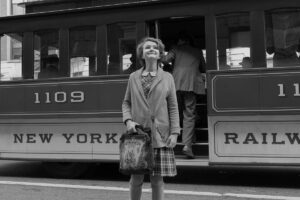
An adaptation of the 2011 novel by Brian Selznick, who also wrote the screenplay, the dreamy film hops between two eras of New York City. Each period presented its own aesthetic demands, filtered through the additional prism of its young, hearing-impaired main characters’ sonic experiences. Rose (Millicent Simmonds), a deaf girl, runs away from her home in New Jersey to find her actress mother in New York in 1927, while Ben (Oakes Fegley) leaves his aunt in rural Minnesota to locate his father in New York in 1977, after losing his hearing. Both children encounter a spectrum of the city — from its heyday in the 1920s to its nadir in the 1970s — and wind up at the Museum of Natural History. There, each finds a salvation in family and friendship.
Gonçalves and Shatz have both worked frequently with Haynes. Shatz first served as a re-recording mixer with the director on Far From Heaven (2002), while Gonçalves co-edited (with Camilla Toniolo) Haynes’ HBO miniseries Mildred Pierce (2011), on which he also collaborated with Shatz for the first time. CineMontage interviewed the editors in early October.
CineMontage: You both have had multiple collaborations with Todd Haynes. How has the process evolved?
Affonso Gonçalves: Todd’s is a specific process that I’ve never had with any director before. While he was shooting Wonderstruck, I was cutting in New York. He doesn’t watch any of the footage while he’s shooting. Once he’s done, he goes away for two weeks to decompress, and I finish my version of the cut.
When he comes back, he watches the footage by himself, takes extensive notes and sends them to me; then I do a completely new version based on his notes. By the time I finish, there’s a version that I cut by myself, and a version that he thought of by himself. Then we join forces and start working together. He’s very specific about the performances he wants to use. His version of the cut is usually our blueprint.
Leslie Shatz: Todd is a director with a strong vision, but he’s also really collaborative. He operates at a very high level aesthetically and has a lot of references. You’ve got to bring your A-game because he’s going to be talking about movies from the ’50s, ’60s and ’70s, and you should be prepared to understand the meaning of the references.
He wants to be surrounded by people who understand him and tries to solicit their opinions — including from assistant editor Perri Pivovar, who did a lot of the preliminary sound work before I came on. It informs Todd about what the possibilities are, but in the end, he makes his own decision — which often goes against what everybody else said!
CM: In Wonderstruck, there are two starkly different worlds and stories that you’re creating and moving between — both in terms of time period and the characters’ inner worlds. How did you define them?
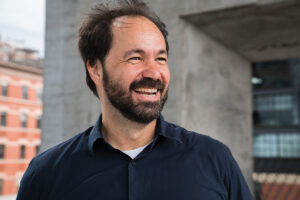
AG: Rose’s story was defined by the way she perceived her world, and also the way we chose to portray that world visually rather than sonically. It’s very tactile; she builds models, she constructs things out of paper, she touches the meteorite, she has a deeply curious mind. So I tried to emphasize those qualities. Ben’s story is different — not only in the sense that it takes place 50 years in the future, but he just got struck by lightning and his whole world has changed. He’s learning how to communicate, he’s trying to re-think how he’s going to travel through his world from this point on. So the idea was to play with sounds, as paradoxical as it may seem, but to transition from a life of hearing to one where you perceive things in different ways.
LS: It was one of the biggest challenges I’ve had, because there are no precedents for what we were trying to do, except for the clichés that people use to represent deafness, such as the ringing tone or muffled sounds. Todd rejected all of that, and rightly so, because he said, “This just makes it sound like they’re hearing it when they’re not.” But we wanted to get inside of the characters’ heads. We needed sound that would be a metaphor for what they were hearing — or what the impulses of sound might have done in their brains, had they been able to hear.
It took quite a bit of experimentation, but I found myself using musical instruments or musical-type sounds in non-musical ways because those could not be mistaken for real or concrete sounds. I used an autoharp to make percussive sounds. When watching the movie, you probably won’t be able to recognize these sounds as coming from my side of the board, because they are pretty well integrated into Carter Burwell’s score.

CM: How did he feel about that?
LS: I have to say that Carter was a very good sport about it, because I introduced a lot of dissonance into his score. Some of what I did was tonal but dissonant, like the autoharp. I also found this instrument called a wind harp, which is exactly what it sounds like: a harp that you put outside and the wind blows through it to create these undulating tones that don’t have a key. I used them a lot in the museum scenes, where they find the Cabinet of Wonders. I found different recordings from around the world. They’re beautiful, rich sounds, and they have a great feeling of wonderment in them.
For Wall Street and Lower Manhattan, we wanted to create that feeling of busyness and hectic-ness without using pedestrians or dialogue. We did a Foley session just with odd Foley props. We used tubes and ratchets, and played saws with a bow. For the feeling of applause in the movie theatre, we had a ratchety sound. For the electric sign, we wanted undulating sounds. Without over-doing it, we tried anything that could create that stimulus in the characters’ brains and find the sound that represented it.
CM: What did Haynes think of it?
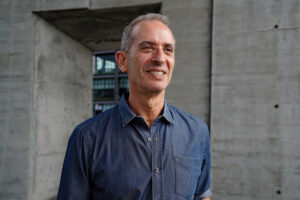
LS: Todd pulled it all back, thankfully. Of course, we did overdo it — like most good sound people do. I’d like to say we had these genius ideas and created them seamlessly, but it was really more: “Let’s try this.” “No, that doesn’t work.” “Oh, this might work.” “Nope. Try again…” And you do that all day long. Frequently, at the end of the day, you’re saying, “I am a failure at this.” But the next day, it becomes, “Wow! That really works,” and you feel inspired to keep going forward.
CM: Was it also a lot of trial and error figuring out how to balance the two storylines until they merge?
AG: It was, I have to say. The stories go back and forth a lot in the script, but that interruption becomes exhausting. We started to blend two scenes that were supposed to be intercut, so we could stay in one story a little longer. After a third of the movie, it slows down — but the first third is very much back and forth. However, too much of that became disturbing to the story. So I would stay with one story longer, so you could actually get invested in it.
The 1927 story was like a silent movie, but was actually shot with sound. All the dialogue that we don’t hear actually exists. So I cut a version with sound and we watched it. I found that when I stripped all the sound out, I had to re-cut it entirely because you understand things at a completely different speed. Some things you understand much faster; you wouldn’t need dialogue. You would see something and move on. The way you pass information is way more economical and direct. Sometimes the actors upped their performance, as in a silent movie, which also helped the emotion.
But there were also times I needed to slow it down to give whatever was happening in front of the camera time to develop, because you don’t have the information that comes with dialogue or sound. Millie, the actress, is incredibly expressive, which helps. She makes a small turn of the head or an eye move and you immediately know what it is. Then you get her cadence and her presence. She has a specific way of walking and moving, and turning things around. She acts like a teenager, but it’s in that black-and-white, silent movie form. It was very interesting. Then, in the 1970s part with Oakes, there is also a specific pace. It’s a little softer…jagged, I would say.
CM: How did you balance the storylines on the soundtrack?
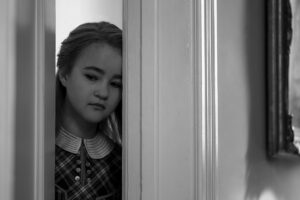
LS: We tried to keep the black-and-white periods very spare. Since the boy in the ’70s has more of the possibility of hearing — and did hear at one point — we tried to go in and out of the feeling of hearing, just to show how that was possible. We would have him standing in a scene and have the real sounds of the scene, and then go to his point-of-view and make it suddenly like we’re in his world; you get this very subjective feeling. It was difficult because some of the shots were very clearly his point-of-view, but other times it was a judgment call.
In the Port Authority scene, I remember Todd called me and said, “No, I’ve decided this has got to be in his point-of-view.” So we put in a siren, but he is able to hear just the slightest amount of siren. So it sounds like a pig squealing, but when you cut to the full, non-POV shot, it becomes the siren.
CM: What were the filmic references for Wonderstruck? I heard you guys were watching a lot of Nicolas Roeg films?
AG: Wow, that’s inside information. We did, yeah. You don’t watch Wonderstruck and think of Nic Roeg, but both Todd and I really like the way Roeg’s films are cut, directed and sound designed so specifically. He can tell stories just using visuals because he was originally a DP. His cutting is extremely jagged. So we would watch and talk about it, and there are a few places here and there that I tried a Roegian cut. But really, it’s about how he tells a story in which different narratives are happening at the same time.
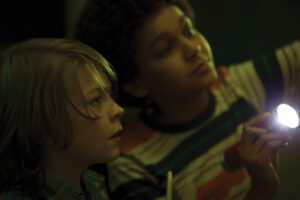
Our scene with the meteorite at the museum — when we have our two characters there at the same time — is definitely a Nic Roeg reference. The two parts are in dialogue and, for the first time, the two stories touch each other. I also watched a lot of silent movies to understand the pace, the ideas, the work with music and sound. Silent movies often used music as sound design, like that amazing scene of Chaplin in Modern Times when he starts losing his mind, screwing the bolts. The music tracks the action and in a way “designs” it with sounds. The music enhances and highlights his movements the way sound effects would do, for instance. Or that beautiful shaving sequence where his moves mirror Brahms’ Hungarian Dances. In a sense, music often did the work of a sound designer on silent movies. So, a lot of Lillian Gish movies were very helpful and a great reference too.
CM: What was the re-recording process like on Wonderstruck?
LS: We tried to maintain the spontaneity of the mixing process by working in long sections and paying special attention to the inter-relationship of sound effects and music created by the absence of any dialogue. Many of the sound effects were created using musical instruments, so there were instances where these sometimes-dissonant combinations had to either be embraced or diminished by eliminating one element or the other. As explained eariler, there are several places in the film where we make the transition from a hearing point-of-view to a deaf point-of-view. Through variable filtering and level adjustment, we tried to give the cinematic representation of what a deaf person might experience.
CM: You both have had the opportunities to work on projects with a variety of budgets. How has technology changed the way you work and affected the creative processes?
AG: On a movie like Wonderstruck that relies so much on visual effects, the fact that I could try them out in my Avid is an amazing advantage. My assistant editor Perri, who’s a great visual effects editor, would create comp versions of what the effects should look like, which helped a lot when we were screening the movie; we didn’t have to imagine how it was going to be, we could actually see an approximation of the end product. That helped with talking to Louis Morin, our visual effects supervisor, to give him a sketch of what we were thinking about.
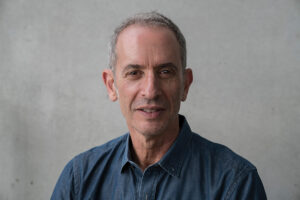
LS: Technology has increased everyone’s capabilities and created amazing possibilities to do excellent work with much fewer resources in terms of crew and time. Some people say the sound mix is the final performance of the filmmaking process. In the past, mixing was actually done in real time without stopping; mix moves had to be memorized and rehearsed, truly a performance. Now we can stop, go back, undo, redo and even mix without listening by drawing lines on a screen.
But when I look back at the films from the 1960s and ’70s that I love, I am amazed at how effective their simpler approach can be. I wonder whether we’ve lost something in our pursuit of the next great leap forward.
CM: Can you talk about the most dysfunctional collaboration you’ve ever experienced and what you learned from it?
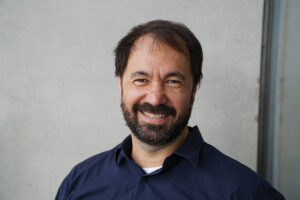
AG: I don’t think I’ve ever had a project that was dysfunctional in terms of collaboration. I’ve been so grateful and lucky to work with directors who are open to ideas and to experimentation — who actually encourage collaboration. But I have had difficult projects owing more to budgetary concerns or deadline issues, and basically you adjust to it accordingly.
I’ve worked on a project that had very little money for music but we had no idea how little until the very end, so we had to change almost the entire soundtrack of the movie. It ended up being a challenging but rewarding experience. We found really great music that was less obvious and sometimes even better than we had originally.
LS: My first film as a sound designer was Mishima [1985], directed by Paul Schrader. Paul was first a film critic, then became a writer and then a director. I tried to introduce electronic sounds from a synthesizer to accompany the brightly colored set pieces staged from Mishima’s novels. During the playback, Paul leaned over to me to praise me — I thought — but said: “When are you going to stop ruining my movie?”
I was devastated, really upset, but later understood that as a film critic he knew of no precedent for sounds like these. After several screenings, he became used to the sound design, which eventually remained in the movie, and we later became friends. I cherish this moment now as an example of how there are many different ways to interpret sounds in a movie.



